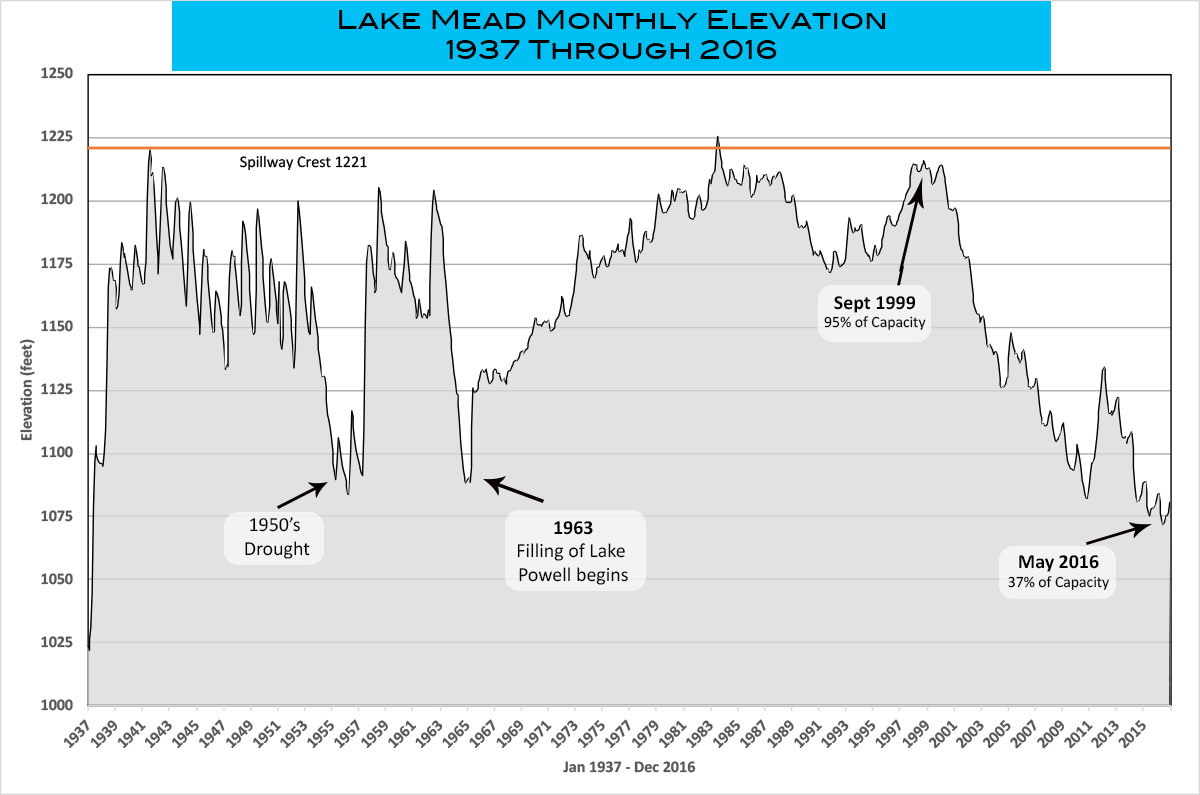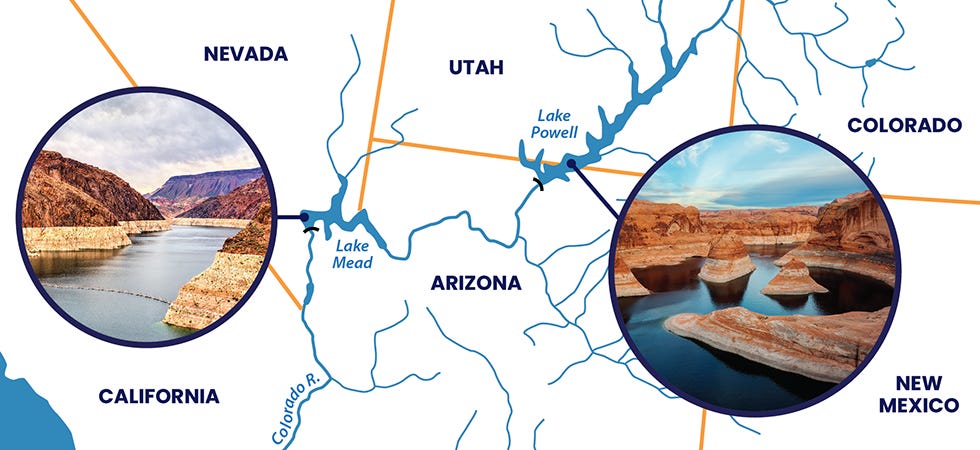Dead pool days
The two largest reservoirs in the US are drying up
It’s summer. There is hardly a day under 80 degrees. We’ve all heard the news about excessive heat in many places worldwide. I report on some of these climate change effects in my Weekly Weird News as well as the stories about some of the U.S.’s greatest water features that are threatened with extinction. I live in Pennsylvania where we are water-rich. But still, we plan for droughts. I feel guilty running the tap for too long! There is no sense in wasting water even when there is enough.
Whenever I visited Las Vegas, I was appalled at the lack of water conservation in this desert area. The payment for over-withdrawal of water resources has come due, and the hit from climate change means it has come faster and more drastically than anticipated.
Lake Mead and Lake Powell are both along the Colorado River in an arid region. They are managed together as the primary water resources for the Southwest. Both are at record low levels. They may never recover. The seven states that rely on the Colorado River must cut 2 - 4 million acre-feet of water use by mid-August. If not, the federal government will act. There is no plan. Cuts will be brutal.
The future is evaporating fast. The US Southwest has had 23 consecutive years of drought - conditions worsened by climate change but also by populations in desert areas that overconsumed the water resources. The reality of desert water resource management is bearing down on the Southwest. The water is gone. You can’t readily get it back. They have sucked their aquifers dry, they have rigged their rivers, and the flows are down to a trickle. This plan has worked pretty well so far but thanks to climate change, it’s failing.
This article from the LA Times about Lake Mead is apocalyptic. I hate to use that word but it’s appropriate here.
The lake’s surface is at about 1,045 feet above sea level. If it drops another 150 feet, there will not be enough water flowing through Hoover Dam to supply large metropolitan centers downstream, including Las Vegas, Phoenix, Los Angeles and San Diego. When that happens, Lake Mead will be a “dead pool.”
For Lake Powell, the lake level where the Glen Canyon Dam turbines can operator is called the “minimum power pool”. If the level falls below that, there is no electricity generated. Other problems occur when the water can’t be released by the dam and must be funned through an inadequate piping system. The failure of Lake Powell means a more rapid death to Lake Mead further downriver.
Lake Mead, created in the 1930s with the construction of the Hoover Dam on the Colorado River, is at 28% capacity, the lowest ever. And it’s not going down slowly, it’s plummeting. The “bathtub ring,” reveals the lake was 180 feet higher in its better days.
Twenty feet of water elevation was lost just this year. In the shallows, people are actively searching for human remains and long-lost objects. The dead bodies and old boats retrieved make headline news.
Online groups have sprung up dedicated to documenting the dramatic disappearance of a lake that supplies electricity to 350,000 homes as well as irrigation and drinking water to some 25 million people across the Southwest.
There has been much written about the water woes of the US Southwest. There have been an endless series of warnings about expanding (instead of moderating) water use. Nothing substantive has been done.


We will see this catastrophe come to fruition in our lifetime. I would predict that the incredible natural places and cities we have taken for granted - the Grand Canyon, Las Vegas, Phoenix, Los Angeles - will be forever altered. I expect water wars and eventual installation of expensive desalination or water reuse facilities. Livestock and wildlife will die, food production will fail, towns will be abandoned. Things are going to get worse.
If there was an easy and good answer, we would have implemented it already.
As an environmentalist, this is hard to write. It’s not fun or satisfying to say “I told you so” when highly predictable and somewhat preventable bad things happen because lawmakers, resource managers, corporations, businesses, and much of the public chose greed, apathy, and carelessness. It’s not like we couldn’t have seen this coming. But, collectively, we failed as a society to do enough or make the hard choices.
If you are in a water-rich area, there may not be much you could do to help with a problem that seems far removed. If you are in the Colorado River basin, conserve water like there is no tomorrow and install solar panels or wind turbines to make up for the lost electricity generation. ALL Americans will pay the price as this drought catastrophe worsens each day. These are strange times, indeed, and they are of our own making.



